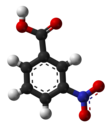3-Nitrobenzoic acid is an organic compound with the formula C6H4(NO2)CO2H. It is an aromatic compound and under standard conditions, it is an off-white solid. The two substituents are in a meta position with respect to each other, giving the alternative name of m-nitrobenzoic acid. This compound can be useful as it is a precursor to 3-aminobenzoic acid, which is used to prepare some dyes.[2]
| |||
| Names | |||
|---|---|---|---|
| Preferred IUPAC name
3-Nitrobenzoic acid | |||
| Other names
m-Nitrobenzoic acid
| |||
| Identifiers | |||
3D model (JSmol)
|
|||
| ChEBI | |||
| ChEMBL | |||
| ChemSpider | |||
| ECHA InfoCard | 100.004.099 | ||
PubChem CID
|
|||
| UNII | |||
CompTox Dashboard (EPA)
|
|||
| |||
| |||
| Properties | |||
| C7H5NO4 | |||
| Molar mass | 167.12 g/mol | ||
| Appearance | cream-colored solid | ||
| Density | 1.494 g/cm3 | ||
| Melting point | 139 to 141 °C (282 to 286 °F; 412 to 414 K) | ||
| 0.24 g/100 mL (15 °C) | |||
| Acidity (pKa) | 3.47 (in water)[1] | ||
| -80.22·10−6 cm3/mol | |||
| Related compounds | |||
Related compounds
|
Benzoic acid Nitrobenzene Anthranilic acid 3,5-Dinitrobenzoic acid 2-Nitrobenzoic acid 4-Nitrobenzoic acid | ||
Except where otherwise noted, data are given for materials in their standard state (at 25 °C [77 °F], 100 kPa).
| |||
Preparation
editIt is prepared by nitration of benzoic acid at low temperatures. Both 2-Nitrobenzoic acid and 4-Nitrobenzoic acid are produced as side products, with yields of approximately 20% and 1.5% respectively.[2] Since carboxylic acid functional groups are electron withdrawing, during an electrophilic aromatic substitution reaction of nitration, substituents are directed to a meta position which explains this regiochemistry.
A less efficient route involves nitration of methyl benzoate, followed by hydrolysis.[3] Alternatively, oxidative C-C bond cleavage of 3-nitroacetophenone to the corresponding aryl carboxylic acid, has been demonstrated.[4] A further synthesis involves the oxidation of 3-nitrobenzaldehyde.
Properties
editWith a pKa of 3.47,[1] 3-nitrobenzoic acid is about ten times more acidic than benzoic acid. The conjugate base of benzoic acid is stabilised by the presence of the electron withdrawing nitro group which explains its increased acidity in comparison to unsubstituted benzoic acid.[5] It is typically soluble in oxygenated and chlorinated solvents.[6]
Reactivity
editThe presence of both carboxylic acid and nitro functional groups deactivate the ring with respect to electrophilic aromatic substitution reactions.
Safety
editThe compound is likely of modest toxicity, with LD50 (i.v., mouse) of 640 mg/kg. This compound can cause skin and eye irritation with symptoms of exposure including methemoglobin, sensitisation, irritation, and corneal damage.[7]
References
edit- ^ a b "Dissociation Constants Of Organic Acids And Bases". Retrieved 11 April 2010.
- ^ a b Takao Maki, Kazuo Takeda (2002). "Benzoic Acid and Derivatives". Ullmann's Encyclopedia of Industrial Chemistry. Weinheim: Wiley-VCH. doi:10.1002/14356007.a03_555. ISBN 978-3527306732..
- ^ Oliver Kamm and J. B. Segur "m-Nitrobenzoic Acid" Org. Synth. 1923, volume 3, 73.doi:10.15227/orgsyn.003.0073
- ^ Li, Meichao; Shen, Zhenlu; Xu, Liang; Wang, Shengpeng; Chen, Bajin; Hu, Xinquan; Hu, Baoxiang; Jin, Liqun; Sun, Nan (2018-05-16). "Oxidative C–C Bond Cleavage for the Synthesis of Aryl Carboxylic Acids from Aryl Alkyl Ketones". Synlett. 29 (11): 1505–1509. doi:10.1055/s-0037-1609751. ISSN 0936-5214. S2CID 104110049.
- ^ "20.4 Substituent Effects on Acidity". Chemistry LibreTexts. 2017-08-25. Retrieved 2018-09-25.
- ^ Ashford, Edith. Benezit Dictionary of Artists. Vol. 1. Oxford University Press. 2011-10-31. doi:10.1093/benz/9780199773787.article.b00007872.
- ^ "M-Nitrobenzoic acid". CAMEO Chemicals. Retrieved 2018-09-25.

